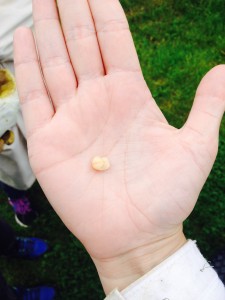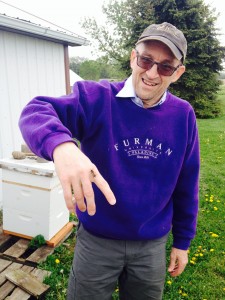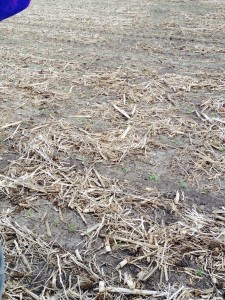With the weather being off and on we didn’t know how the day would go, but we lucked out and got to see the bees with Mark Tintjer. It was crazy how much goes into bee keeping. We started looking at just three colonies and watched as Mark transferred the bees from one small hive to a larger one. He smoked them before he did so to calm them down because it was supposed to make them think it was a forest fire; in the forest scenario, the bees would want to store honey in case they had to flee. He pulled out each row of honey comb to try to find the queen bee to show us. The process is very neat on how the hive operates. The drones, or males, are only made to fertilize the eggs. They have no other purpose because all the worker bees are female. The queen bee has no stinger so she can’t die and she is fed royal honey at the beginning to become fertile and bigger than the rest. The colonies attitudes reflect the queen bee, which I found fascinating. Also its a long process from when Mark gets the honey out to when its ready to eat–a very time consuming process, which until our visit this afternoon I never knew. And honey is HEAVY! The bees also produce an insane amount. In 2013, his 42 hives produced 2.5 tons of honey. WOW! Also, we ate a drone bee larvae. It was very slimy and very gross, but apparently a good source of protein.
Another topic that was touched on by Mark and his wife was the harmful effects of the pesticides being sprayed on the corn fields by his neighbors. The wind blew these pesticides onto the Tintjners’ organic garden and exacted significant damage.. The pesticide drift caused a dramatic loss to their vegetables and impacted the food they were able to put on the table that year. Finally they filed a claim and got reimbursed for the loss of the produce. Even though they got the money back they were not able to enjoy their organic veggies because of the harmful effects of pesticides.
Lastly, we went to a no till farm ran by a man named Glen Hodnefield who had been using no-till practices since 1991. The land has been in his family for over 100 years and he was very proud that he was keeping it going, along with the innovations he had made to the farm practices. By using no till he was able to minimize soil erosion. He showed us a spot where the soil would have been moved by a rainstorm but rather than washing out the corn plants, the water moved the residue, not the topsoil. He also informed us on the drainage system of the farm and showed us the tile that was under the ground taking the water away so the Iowa pot hole prairie could be farmed.. It’s hard to imagine that people put these tiles down by hand in the early 20th century. The amount of work that went into the land to make it able to farm on is very impressive.




